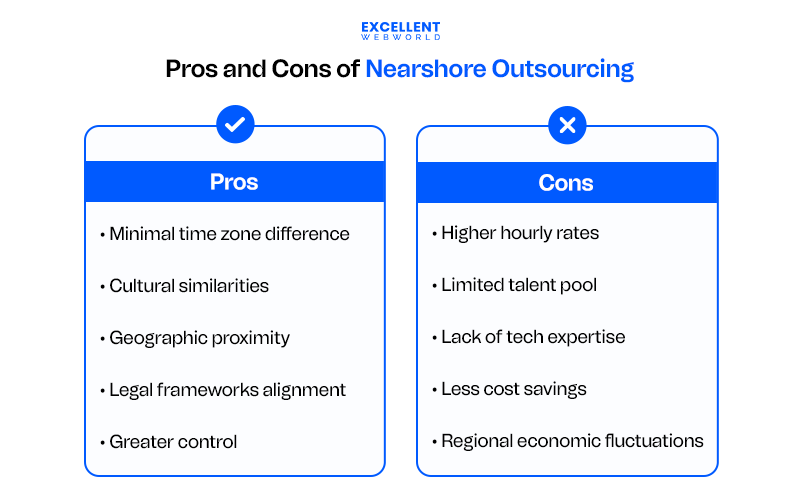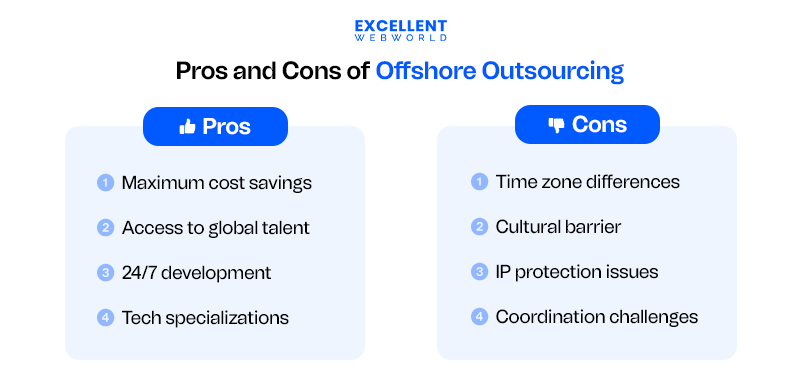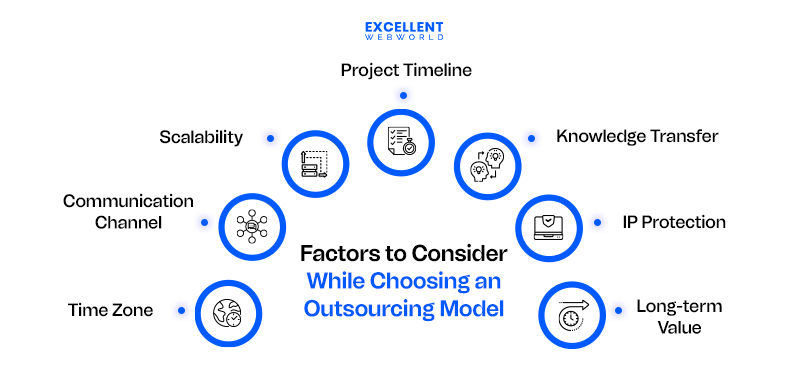The IT outsourcing marketplace is experiencing a considerable surge, driven by the demand for specialized expertise and cost-effective software development solutions. 85% of IT outsourcing projects deliver services that match or exceed in-house capabilities, specifically in cloud, AI, software development, and data analytics. (Source: Auxis)
Yet, hiring skilled IT specialists remains an assignment. 57% of hiring managers struggle to discover qualified skills, even as 43% plan to expand their IT teams in 2025. This is fueling fast growth, with the IT outsourcing market projected to attain USD 150.48 billion by 2029. (Source: Business Research Company)
In this landscape, outsourcing is not an option but a necessity. But do you have to go with nearshore vs offshore? This guide will break down nearshore vs offshore outsourcing differences, helping you pick the correct approach for custom software development based on your particular project requirements.
What is Nearshore Outsourcing?
Nearshore outsourcing is a business practice where a company contracts with service providers in a neighboring country or one with a similar time zone to perform specific tasks, rather than hiring an in-house team or using distant offshore providers.
One of the nearshore outsourcing examples would be a company based in the UAE, Kuwait, or Saudi Arabia might outsource its software development needs to a nearby country like India through specialized nearshore software development services.
Many companies outsource nearshore IT for end-to-end software development, making the most of improved communication and faster project assignments. With nearshore software development, you can access professional experts nearby, making aligning organizational dreams and technical requirements easier.
Nearshore outsourcing development offers proximity, but offshore outsourcing (the alternative to software development outsourcing) provides lower fees and various skill sets by extending operations to more distant regions. Let’s discover more about that in the following section.
What is Offshore Outsourcing?
Offshore outsourcing is a business practice where a company hires a third-party provider located in a different country to perform specific business functions. The offshore outsourcing model allows companies to reduce fees while accessing specialized expertise. Many firms choose offshore software development for building digital products because it permits them to work with professional experts without the cost of an in-house team.
It also provides customers with access to cutting-edge software solutions while offering scalability and flexibility. However, factors such as time zone variations and communication challenges must be considered before deciding where to outsource. For instance, if you’re outsourcing app development to a country like India while being based in the US, you need to verify whether the company you’re outsourcing to operates during overlapping hours for both zones. You might find it helpful to read this list to know about the best countries to outsource software development.
Now that we’ve explored the basics of nearshore and offshore outsourcing, weighing their pros and cons is vital. Understanding them will assist you in making knowledgeable decisions based on value, performance, and enterprise wishes.
Pros and Cons of Nearshore and Offshore Outsourcing
Knowing the advantages and limitations of various outsourcing models is vital when looking for a custom-built software solution. Specifically, when deciding between nearshore vs offshore. Let’s discover the offshore and nearshore outsourcing advantages and downsides that affect your software development process and the overall project success.
Pros and Cons of Nearshore Outsourcing
Pros:
Cons:
Pros and Cons of Offshore Outsourcing
Pros:
Cons:
Now that we understand the pros and cons of nearshore and offshore, we can better examine how they compare throughout key parameters. This assessment will assist you in choosing the version that best suits your organizational goals.
Nearshore vs Offshore Outsourcing: A Parameter-Based Comparative Analysis
When considering outsourcing alternatives to your app & software development projects, knowing the differences between nearshore and offshore models is crucial for making the right choice. Each method offers incredible benefits depending on your particular needs and priorities.
Before going into the in-depth evaluation, let’s see the crucial parameters that differentiate nearshore and offshore outsourcing:
| Parameter | Nearshore | Offshore |
|---|---|---|
| Geographical Location | Same region or neighboring countries | Distant countries, often across multiple time zones |
| Project Requirements | Better for complex, collaborative projects | Suitable for well-defined, independent tasks |
| Cultural Affinity | Higher similarity and fewer differences | May have significant cultural disparities |
| Cost | Moderately lower than domestic rates | Significantly lower rate |
| Access to Talent | Regional talent pools | Global talent pools |
| Convenience & Collaboration | Easier due to similar time zones | More challenging due to time differences |
| Developer Skills | Specific regional expertise | Diverse global expertise |
| Regulations & Compliances | Often similar legal frameworks | May have vastly different regulations |
To determine which model best suits your business needs, examine each parameter in detail.
1. Geographical Location
Nearshore outsourcing web development includes working with teams in neighboring countries or the same region. For example, US companies may partner with developers in Mexico, Canada, or Latin America, while European firms may pick out Eastern European partners.
Offshore outsourcing, then again, includes collaboration with teams in remote international locations, generally throughout multiple time zones, such as US organizations working with teams in India or the Philippines.
Winner: Nearshore – The proximity reduces travel time and fees, while in-person conference calls are vital and minimize time differences that can bog down collaboration.
2. Project Requirements
Project complexity significantly influences which outsourcing model is most appropriate.
Nearshore partnerships excel when projects require:
Offshore models often work better for:
When implementing various software development frameworks, your project’s methodology will influence the best model. Agile projects benefit from nearshore collaboration due to the need for regular synchronous communication, while waterfall approaches may work well with offshore teams.
Winner: This depends on the project type. Nearshore is for complex, collaborative projects; offshore is for well-defined projects with longer timelines.
3. Cultural Affinity and Language Barrier
Cultural alignment and communication ease are frequently underestimated elements in outsourcing success. Nearshore groups share cultural similarities, holidays, and enterprise practices with their domestic teams. This cultural proximity usually translates to fewer misunderstandings and smoother collaboration.
Language boundaries can extensively impact mission outcomes. While English proficiency is widespread in many offshore locations, subtle communication nuances and context can still wander away when working across massively distinctive cultures.
Winner: Nearshore – Generally offers better cultural alignment and fewer communication challenges.
4. Cost Breakdown
While value is often the primary motivation for outsourcing, the whole picture includes more than hourly charges. Here’s an in-depth breakdown of the software development cost across different regions:
| Client Region | Nearshore Countries | Nearshore Rate (USD) | Offshore Countries | Offshore Rates (USD) |
|---|---|---|---|---|
| USA | Canada, Mexico | 50-65 | India, Philippines | 20-50 |
| Canada | US, Mexico | 50-65 | India, Philippines | 20-50 |
| Western Europe | Poland, Romania, Ukraine | 40-60 | India, Philippines, Vietnam | 20-50 |
| Eastern Europe | Ukraine, Romania | 35-55 | India, China, Malaysia | 20-55 |
| Middle East | India, Philippines | 20-45 | US, Canada, Mexico | 50-65 |
| Asia (Japan/South Korea) | India, Malaysia, | 20-40 | US, Canada, Mexico | 50-65 |
| Australia/New Zealand | Philippines, Malaysia, Singapore | 35-55 | India, Vietnam | 20-45 |
[ Sources: Accelerance, Clutch, and Stack Overflow’s Developer Survey ]
Note: Pricing Subject to Scope & Final Assessment
While offshore rates appear significantly lower, it’s important to consider hidden costs:
The total software development cost often narrows the gap between the two models when these factors are considered in software project estimation.
According to Deloitte’s Global Outsourcing Survey, businesses report a median of 15-20% in “hidden charges” with offshore arrangements compared to 5-10% with nearshore partnerships.
Winner: Offshore – Still typically provides the lowest overall cost, especially for longer-term projects, despite additional overhead.
5. Access To Talent
When you want to hire dedicated software developers, your geographical region affects the talent pool available.
Offshore outsourcing offers access to large talent pools in global places like India, China, and the Philippines, where tens of millions of technical graduates enter the workforce yearly. These areas often concentrate on particular technologies and may offer expertise at scale.
Nearshore destinations may have smaller but often highly skilled talent pools. For example, Eastern European nations excel in mathematical and algorithmic development, and Latin American developers usually convey creative and design talents.
Winner: Offshore – Provides access to significant skill pools and specialized expertise throughout a broader range of technology.
6. Convenience and Collaboration
Time zone alignment significantly impacts day-to-day collaboration.
Nearshore teams typically operate within 1-3 time zones of your location, enabling:
Offshore teams may operate with minimal or no overlap in working hours, requiring more asynchronous communication and potentially extending project timelines.
Winner: Nearshore – Offers more convenient real-time collaboration and faster response times.
7. Developer Skills
Both models offer access to proficient developers but with different strengths. It varies primarily based on the particular competencies you need.
Nearshore regions often feature:
Offshore destinations typically offer:
Winner: Tie – Both models provide access to skilled developers with different specializations.
8. Regulations and Compliance
Navigating legal troubles will become more and more crucial as data privacy rules tighten globally. Nearshore agencies often perform similar or like-minded legal frameworks, making compliance straightforward.
When working with offshore teams, you may encounter:
When dealing with sensitive information or developing solutions like healthcare app development or finance app development, you must comply with the industry standards.
Winner: Nearshore – Generally offers more compatible regulatory environments and straightforward compliance.
Summary: Offshore vs Nearshore Outsourcing
| Parameter | Nearshore | Offshore | Winner |
|---|---|---|---|
| Geographical Location | ✅ | ❌ | Nearshore |
| Project Requirements (Well-Defined) | ❌ | ✅ | Offshore |
| Cultural Affinity | ✅ | ❌ | Nearshore |
| Cost | ❌ | ✅ | Offshore |
| Access to Talent | ❌ | ✅ | Offshore |
| Convenience & Collaboration | ✅ | ❌ | Nearshore |
| Developer Skills | ✅ | ✅ | Tie |
| Regulations & Compliance | ✅ | ❌ | Nearshore |
The ideal outsourcing model ultimately depends on your specific priorities. If cost is your primary concern, offshore might be best. If collaboration and cultural alignment matter the most, nearshore might be preferred.
Now that we’ve explored the key differences between nearshore and offshore outsourcing, we must recognize the suitable model. In the subsequent section, we will discuss the vital factors to consider when making that choice.
How to Choose the Best Outsourcing Model? Factors to Consider
Selecting the proper outsourcing model requires careful assessment of more than one business factor. Consider these critical elements before making your decision.
1. Time Zone Compatibility
Evaluate whether your enterprise needs real-time collaboration or can function efficiently with asynchronous communication. Nearshore development outsourcing offers overlapping work hours, while offshore partnerships may require schedule changes.
2. Communication Infrastructure
Assess the excellence and reliability of digital infrastructure in outsourcing places. Strong internet connectivity and modern collaboration equipment enable seamless interactions with your extended group, using diverse software developer technologies.
3. Scalability Needs
Consider how quickly you need to scale your team up or down. Some regions offer greater flexibility for rapid scaling, especially when looking for AI experts to work on specialized services like AI development or Generative AI development.
4. Project Timeline Sensitivity
Time-sensitive initiatives benefit from models enabling frequent check-ins and quick pivots. When time limits are essential, the capability to collaborate in real-time can help mitigate modern business challenges with a modern digital-first approach.
5. Knowledge Transfer Requirements
Evaluate how much domain knowledge needs to be shared between your internal team and outsourced partners. Some software development consulting firms offer comprehensive onboarding processes to ensure alignment with your business goals.
6. Intellectual Property Protection
Research the legal frameworks for IP protection in potential outsourcing destinations. Nearshore outsourcing companies often operate under legal systems similar to those in your home country, potentially reducing legal complexities.
7. Long-term Strategic Value
Consider whether you need a transactional vendor relationship or a strategic partner who can help, from design to development. The right model helps your long-term innovation dreams past immediate project needs.
When weighing in-house vs outsourcing alternatives, consider that your preference aligns with your unique enterprise context, project necessities, and business culture.
Optimize Your Project Cost By Partnering With Excellent Webworld For Offshore Outsourcing
Making the ideal choice between nearshore and offshore outsourcing is crucial. However, having a perfect partner is even more critical. Excellent Webworld stands as your perfect outsourcing offshore companion with proven expertise.
Here’s why you should choose us for software development outsourcing:
Hire dedicated developers from our firm with extensive experience and a commitment to excellence that guarantees your project’s success while optimizing project prices. Additionally, suppose you require help deciding on the basis of what’s more that outsourcing, be it nearshore or offshore, can offer you. In that case, you can consult with our expert IT business consultants.
Ready to elevate your digital presence without breaking the bank? Take the first step toward innovation – schedule your strategic consultation right now!
FAQs
Offshore outsourcing involves partnering with companies in distant countries (often across oceans), while nearshore refers to outsourcing to neighboring or nearby countries with similar time zones and closer cultural alignment.
A typical example is US companies outsourcing to Mexico or Canada, or European companies working with partners in nearby Eastern European countries like Poland or Ukraine.
Nearshoring offers easier communication due to similar time zones, reduced travel costs, cultural proximity, and often similar legal frameworks while providing cost advantages compared to domestic operations.
Nearshore typically allows for real-time collaboration and faster problem-solving with fewer communication barriers. At the same time, offshore may offer more significant cost savings, but with potential challenges in coordination and oversight.
Yes, nearshore services are typically more expensive than offshore options but less costly than domestic services, representing a middle-ground pricing option with the added benefits of proximity.
Nearshore partners operate in similar or overlapping time zones, allowing for real-time collaboration during standard business hours, while offshore arrangements often involve significant time differences requiring asynchronous work or adjusted schedules.

Article By
Mahil Jasani began his career as a developer and progressed to become the COO of Excellent Webworld. He uses his technical experience to tackle any challenge that arises in any department, be it development, management, operations, or finance.






